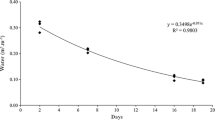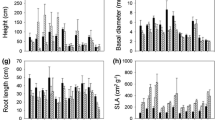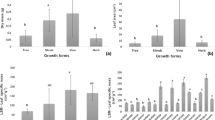Abstract
The neotropical liana Croton nuntians (Euphorbiaceae) can occur in a variety of different growth habits. Juvenile freestanding plants are mechanically stable without support and resemble morphologically young trees or shrubs, whereas adult plants are climbers. Ontogenetic variation of bending and torsion properties of different growth phases are analyzed by measurements of flexural stiffness, structural bending modulus, torsional stiffness and structural torsional modulus. Mechanical and anatomical data show two fundamentally different patterns for juvenile freestanding and adult climbing plants. In freestanding plants, mechanical properties and the contribution of cortex, wood, and pith to the stem cross-section vary only little during ontogeny as is typical for semi-self-supporting plants. In contrast, climbing plants become significantly more flexible during ontogeny, as is characteristic for lianas. This is accompanied by a transition to the formation of a less dense wood type with large diameter vessels and an increasing contribution of flexible tissues (less dense wood and cortex) to the cross-sectional area and the axial second moment of area of the stems. Depending on the environmental conditions, freestanding plants can differ considerably in their appearance due to differences in branching system or stem taper. Therefore the influence of light quantity, measured as percentage of canopy opening, on the mechanical properties and the stem anatomy was tested. Freestanding plants grown with strong shade are significantly more stiff in bending compared with plants grown with a moderate light environment.












Similar content being viewed by others
References
Bell, AB (1994) “A summary of the branching process in plants” In; Ingram, DS, Hudson, A (editors), Shape and form in plants and fungi, Academic Press, London, , pp 119–142
S Bhambie (1972) ArticleTitleCorrelation between form, structure and habit in some lianas Proceedings of the Indian Academy of Sciences 75 246–256
J Bodig BA Jayne (1982) Mechanics of wood and wood composites Van Nostrand Reinhold Co New York
G Caballé (1980a) ArticleTitleGrowth characteristics and vegetative reproduction of the aquatic liana Tetracera alnifolia Willd. (Dilleniaceae) in the Gabon rain forest Adansonia 19 467–475
G Caballé (1993) ArticleTitleLiana structure, function and selection: a comparative study of xylem cylinders of tropical rainforest species in Africa and America Linnean Society 113 41–60 Occurrence Handle10.1006/bojl.1993.1061
G Caballé (1998) ArticleTitleLe port autoportant des lianes tropicales: une synthese des strategies de croissance Can J Botany 76 1703–1716 Occurrence Handle10.1139/cjb-76-10-1703
S Carlquist (1984) ArticleTitleWood and stem anatomy of Lardizabalaceae, with comments on the vining habit, ecology and systematics Bot J Linnean Soc 88 257–277
Chabbert, B, Monties, B, Rowe, NP, Speck, T (1997) “Variability of lignin composition and lignification pattern in the lianescent and self-supporting growth phase of the liana Condylocarpon guianense” In: Jeronimidis, G, Vincent, JFV (editors), Plant biomechanics September 1997, Centre for Biomimetics, The University of Reading, pp 73–78, Conference proceedings I, papers
Coudurier T. 1992. Sur la place des lianes dans la foret guyanaise. PhD Thesis, Universite de Montpellier II
G Cremers (1973) ArticleTitleArchitecture de quelques lianes d’Afrique tropicale 1 Candollea 28 249–280
G Cremers (1974) ArticleTitleArchitecture de quelques lianes d’Afrique tropicale 2 Candollea 29 57–110
C Darwin (1867) ArticleTitleOn the movements and habits of climbing plants J Linnean Soc (Botany) 9 1–118
FW Ewers (1985) ArticleTitleXylem structure and water conduction in conifer trees, dicot trees, and lianas IAWA Bulletin n.s. 6 309–317
FW Ewers JB Fisher (1991) ArticleTitleWhy vines have narrow stems: histological trends in Bauhinia (Fabaceae) Oecologia 88 233–237 Occurrence Handle10.1007/BF00320816
FW Ewers JB Fisher (1995) ArticleTitleXylem vessels in lianas, shrubs and trees of Gnetum and Ephedra Am J Botany 82 12
Ewers, FW, Fisher, JB, Fichtner, K (1991) “Water flux and xylem structure in vines” In: Putz, FE, Mooney, HA (editors), The biology of vines, Cambridge University Press, Cambridge, pp 127–160
FW Ewers MR Carlton JB Fisher KJ Kolb MT Tyree (1997) ArticleTitleVessel diameters in roots versus stems of tropical lianas and other growth forms IAWA J 18 261–279
JB Fisher FW Ewers (1989) ArticleTitleWound healing in stems of lianas after twisting and girdling Botanical Gazette 150 251–265 Occurrence Handle10.1086/337770
Fisher, JB, Ewers, FW (1989) “Structural responses to stem injury in vines” In: Putz, FE, Mooney, HA (editors), The biology of vines, Cambridge University Press, Cambridge, pp 73–97
JB Fisher FW Ewers (1992) ArticleTitleXylem pathways in liana stems with variant secondary growth Bot J Linnean Soc 108 181–202
Gallenmüller, F, Müller, U, Rowe, NP, Speck, T (2000), “Variability of habit and mechanical properties in the neotropical liana Croton nuntians” In: Spatz, HC, Speck, T (editors), Plant biomechanics 200, Georg Thieme Verlag, Stuttgart, pp 63–70, Proc 3rd Plant Biomechanics Conference Freiburg-Badenweiler August 27th to September 2nd 2000
F Gallenmüller U Müller NP Rowe T Speck (2001) ArticleTitleThe growth form of Croton pullei (Euphorbiaceae) - functional morphology and biomechanics of a neotropical liana Plant Biol 3 50–61 Occurrence Handle10.1055/s-2001-11750
BL Gartner (1991a) ArticleTitleStem hydraulic properties of vines vs. shrubs of western poison oak, Toxicodendron diversilobum Oecologia 87 180–189 Occurrence Handle10.1007/BF00325255
BL Gartner (1991b) ArticleTitleStructural stability and architecture of vines vs. shrubs of poison oak, Toxicodendron diversilobum Ecology 72 2005–2015
BL Gartner SH Bullock HA Mooney V By Brown JL Whitbeck (1990) ArticleTitleWater transport properties of vine and tree stems in a tropical deciduous forest Am J Botany 77 742–749
G Haberlandt (1924) Physiologische Pflanzenanatomie. 6. Aufl Engelmann Leipzig
F Hallé RAA Oldeman PB Tomlinson (1978) Tropical trees and forests. an architectural analysis Springer Verlag Berlin, Heidelberg, New York
Hoffman, B, Chabbert, B, Monties, B, Speck, T (2000a) ““Fine-tuning” of mechanical properties in two tropical lianas” In: Spatz, H-C, Speck, T (editors), Plant biomechanics 2000, Georg Thieme Verlag, Stuttgart, pp 10–18, Proc 3rd Plant Biomechanics Conference Freiburg-Badenweiler August 27th to September 2nd 2000
Hoffmann, B, Chabbert, B, Monties, B, Speck, T (2000b) “Mechanical properties and chemical cell wall composition of two tropical lianas” In: Wisser, A, Nachtigall, W (editors), BIONA-report 14, Akademie der Wissenschaften und der Literatur, Mainz, GTBB, Saarbrucken, pp 10–15
B Hoffmann B Chabbert B Monties T Speck (2003) ArticleTitleMechanical, biochemical and ultrastructural properties of wood and their changes during ontogeny in the two tropical lianas Bauhinia guianensis and Condylocarpon guianense Planta 217 32–40
DK Kennard (1998) ArticleTitleBiomechanical properties of tree saplings and free-standing lianas as indicators of susceptibility to logging damage Forest Ecology Management 102 179–197 Occurrence Handle10.1016/S0378-1127(97)00159-X
KJ Niklas (1992) Plant biomechanics. An engineering approach to plant form and function The University of Chicago Press Chicago 607
M Obaton (1960) Les lianes ligneuses a structure anormale des forets denses d’Afrique occidentale Masson Paris
FE Putz (1983) ArticleTitleLiana biomass and leaf area of a “Tierra Firme” forest in the Rio Negro Basin, Venezuela Biotropica 15 185–189
FE Putz (1984) ArticleTitleThe natural history of lianas on Barro-Colorado Island, Panama Ecology 65 1713–1724
FE Putz (1990) ArticleTitleLiana stem diameter growth and mortality rates on Barro Colorado Island, Panama Biotropica 22 103–105
FE Putz P Chai (1987) ArticleTitleEcological studies of lianas in Lambir National Park, Sarawak, Malaysia J Ecology 75 523–531
Putz, FE, Holbrook, NM (1991) “Biomechanical studies of vines’” In: Putz, Fe, Mooney, HA (editors), The biology of vines, Cambridge University Press, Cambridge, pp 73–97
NP Rowe T Speck (1996) ArticleTitleBiomechanical characteristics of the ontogeny and growth habit of the tropical liana Condylocarpon guianense (Apocynaceae) Int J Plant Science 157 406–417 Occurrence Handle10.1086/297357
NP Rowe T Speck (1998) ArticleTitleBiomechanics of plant growth forms: the trouble with fossil plants Rev Palaeobotany and Palynology 102 43–62 Occurrence Handle10.1016/S0034-6667(98)00013-X
Rowe, NP, Speck, T (2002) “Hydraulics and mechanics of plants: novelty, innovation and evolution” In: Hemsley, AR, Poole (editors), The Evolution of Plant Physiology, Kew: Royal Botanic Gardens
Schenck, H (1892) “Beitrage zur Anatomie der Lianen, im Besonderen der in Brasilien einheimischen Arten. 1. Beitrage zur Biologie der Lianen” In: Schimper, AFW (editor), Botanische Mitteilungen aus den Tropen 4, Fischer, Jena, pp 1–253
Schenck, H (1893) “Beitrage zur Biologie und Anatomie der Lianen, im Besonderen der in Brasilien einheimischen Arten. 2. Beitrage zur Anatomie der Lianen” In: Schimper, AFW (editor), Botanische Mitteilungen aus den Tropen 5, Fischer, Jena, pp 1–271
Schenck, H (1912) “Lianen” In: Handbuch der Naturwissenschaften, Bd. 6, pp 176–185
T Speck (1991a) ArticleTitleBiophysikalische Methoden in der Paläobotanik: Möglichkeiten - Problematik Berichte der Naturforschenden Gesellschaft Freiburg i.Br. 79 99–131
Speck, T (1991b) “Changes of the bending-mechanics of lianas and self-supporting taxa during ontogeny” In: Natural Structures. Principles, strategies, and models in architecture and nature. , pp 89–95, Proc of the II. International Symp Sonderforschungsbereich SFB 230 Part I
T Speck (1994) ArticleTitleBending stability of plant stems: ontogenetical, ecological, and phylogenetical aspects Biomimetics 2 109–128
Speck, T, Rowe, NP (1997) “Ecobiomechanics: biomechanical analyses help to understand aut- and synecology of plants” In: Jeronimidis, G, Vincent, JFV (editors), Plant biomechanics September 1997 , Centre for Biomimetics, The University of Reading, Reading, pp 9–15, Conference proceedings I: papers
Speck, T, Rowe, NP (1999a) “A quantitative approach to analytically defining size, form and habit in living and fossil plants” In: Hemsley, AR, Kurmann, M (editors), The evolution of plant architecture, Kew: Royal Botanical Gardens. pp 447–449
Speck, T, Rowe, NP (1999b) “Biomechanical analysis” In: Jones, TP, Rowe, NP (editors), Fossil plants and spores: modern techniques., Geological Society, London, pp 105–109
T Speck NP Rowe (2001a) ArticleTitleDie Wuchsform “Liane” - strukturelle Voraussetzungen fur eine erfolgreiche Einnischung als Kletterpflanze Mitteilungen des badischen Landesvereins fur Naturkunde und Naturschutz 17 875–893
Speck, T, Rowe, NP (2001b) “Plant growth forms and biomechanics” In: Briggs, DEG, Crowther, PR (editors), Palaeobiology II, Blackwell Science, Oxford, pp 379–384
Speck, T, Rowe, NP, Haberer, W, Gallenmüller, F, Spatz, H-C (1996a) “How plants adjust the “material properties” of their stems according to differing mechanical constraints during growth: an example of smart design in nature” In: Engin, AE (editor), Bioengineering PD-volume 77, The American Society of Mechanical Engineers, pp 233–241, Proc 1996 engineering systems design and analysis conference, vol. 5
Speck, T, Rowe, NP, Spatz, H-C, (1996b) “Pflanzliche Achsen, hochkomplexe Verbundmaterialien mit erstaunlichen mechanischen Eigenschaften” In: Nachtigall, W, Wisser, A (editors), BIONA-report 10-Technische Biologie und Bionik 3, Akad. Wiss. und Lit. Mainz. , C Fischer Verlag, Stuttgart, pp 101––131
Speck, T, Neinhuis, C, Gallenmüller, F , Rowe, NP (1997) “Trees and shrubs in the mainly lianescent genus Aristolochia s.L.: secondary evolution of the self-supporting growth habit?” In: Jeronimidis, G, Vincent, JFV (editors), Plant Biomechanics September 1997, Centre for Biomimetics, The University of Reading, Reading, pp 201–207, Conference proceedings I: papers
W Troll (1937) Vergleichende Morphologie der höheren Pflanzen. Erster Band: Vegetationsorgane. Erster Teil Gebrüder Borntraeger Berlin
W Troll (1939) Vergleichende Morphologie der höheren Pflanzen. Erster Band: Vegetationsorgane. Zweiter Teil Gebrüder Borntraeger Berlin 957–2005
W Troll (1943) Vergleichende Morphologie der höheren Pflanzen. Erster Band: Vegetationsorgane. Dritter Teil Gebrüder Borntraeger Berlin 2007–2736
Tyree, MT, Ewers, Fw (1996) “Hydraulic architecture of woody tropical plants” In: Mulkey, S, Chazdon, RL (editors), Tropical forest plant ecophysiology, Chapman and Hall, New York, pp 218–243
Vincent, JFV (1992) “Plants” In: Vincent, JFV (editor), Biomechanics - material: a practical approach, IRL Press, Oxford, pp 165–191
O Warburg (1883a) ArticleTitleUeber Bau und Entwicklung des Holzes von Caulotretus heterophyllus Botanische Zeitung 38 618–632
O Warburg (1883b) ArticleTitleUeber Bau und Entwicklung des Holzes von Caulotretus heterophyllus Botanische Zeitung 42 707–712
M Westermeier H Ambronn (1881) ArticleTitleBeziehungen zwischen Lebensweise und Struktur der Schling-und Kletterpflanzen Flora 69 417–436
O Wilmanns (1983) ArticleTitleLianen in mitteleuropäischen Pflanzengesellschaften und ihre Einnischung Tuexenia 3 343–358
Acknowledgments
We thank Meriem Fournier (SILVOLAB, Kourou) and the scientists of CIRAD, Programme Bois (Kourou) for their great hospitality, valuable discussions and practical support during laboratory and field work. We thank Damien Bonal (INRA, Kourou) for technical support and advice in the light measurements. Marie-Francoise Prevost (ORSTOM, Cayenne) is acknowledged for all her help during field work. In particular, we thank Uli Müller for valuable discussions of the experimental setup and help in mechanical field measurements and measurements of light quantity. This study was carried out with the help of a grant from the Landesgraduiertenforderung Baden-Württemberg, and a DAAD travelling grant to F. Gallenmüller. The study was additionally funded by a Franco-German PROCOPE PROJECT awarded to T. Speck and N.P. Rowe, which is gratefully acknowledged.
Author information
Authors and Affiliations
Corresponding author
Rights and permissions
About this article
Cite this article
Gallenmüller, F., Rowe, N. & Speck, T. Development and Growth Form of the Neotropical Liana Croton nuntians: The Effect of Light and Mode of Attachment on the Biomechanics of the Stem. J Plant Growth Regul 23, 83–97 (2004). https://doi.org/10.1007/s00344-004-0045-z
Received:
Accepted:
Published:
Issue Date:
DOI: https://doi.org/10.1007/s00344-004-0045-z




